How it all began
It started, as many of our birding expeditions do, with advice from our friends the Englemans, who are serious birders. You may have been under the mistaken idea that we are serious birders. The E's raved about their trip to Uganda and convinced us to repeat it. Alas, we found that the tour, which was restricted to a small size, was full. No problema. Dodge had the email address of the Ugandan guide used by the tour company, one Livingstone, whom we learned possesses an encyclopedic knowledge of Ugandan bird life. Dodge dispatched an email to Livinstone, who replied that he would be happy to take Dr. Engleman's friends on a private tour. When the price he quoted was a few hundred dollars less than the tour company's price, we took the plunge.
Entebbe
After a typical flight to a good birding destination — 24 hours or so — we spent the night in a lovely Bed and Breakfast, the Boma Guest House. Over breakfast, we got a start on Ugandan birding when a Black-and-white Hornbill flew into a tree nearby. Livingstone arrived just as the first light of morning showed in the sky, and we were off.
Masindi
Our first stop was the town of Masindi, and a hotel dating from the 1920's. The web site showed a lovely view of the “oldest hotel in Uganda, recently restored to its colonial era elegance.” It also advertised WiFi connection to the internet. Both claims proved to be more poetic than actual, though by third world standards, the hotel was pretty good. We spent most of the day birding our way from Entebbe, picking up many of the birds that would become familiar, as well as our first three species of monkeys.
We spent the next day on the Royal Mile in the Budongo Forest, a true canopy forest. That means a neck breaking attempt to locate birds high above you. Many of these birds weren't likely anywhere else, so we spent considerable effort on them. We were lucky to stumble on a group of Chimpanzees, one who ate placidly nearby, and a troop of ten who crossed the road as we watched.
Murchison Falls
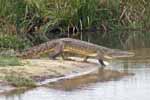
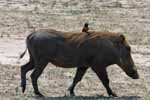
The next day, we were off to Murchison Falls NP, where the Nile flows through a narrow gorge, only 7 meter wide at one point, into Lake Albert. We were there during the dry season, but it was still an amazing sight. Other amazing sights of the area included a huge Nile Crocodile, more Hippos than I thought possible — our boat captain claimed there were 4,000 in the area — and our first look at African Elephants. One of our favorite pictures from there is the Carmine Bee-eater riding on the back of a Common Warthog.
We spent the entire afternoon driving around the game tracks and checking each likely spot in a fruitless search for the Shoebill, the signature bird of Uganda. It's on the advertising photo for the birds of Uganda. We had to be satisfied with a great close up look at a Nile Monitor Lizard, which can be difficult to photograph.
Then it was back to Masindi for the night, and on to
Kibale NP


Kibale is most famous for the large number of Chimpanzees in the area, but for us, it was the site of the best bird of the trip. We arose an hour before dawn in time to grab breakfast at the Primate Lodge before setting out with Gerald T, which we rendered as “Jared,” our local guide. We trekked through the forest on a muddy trail in the dark before arriving at our destination, a lek of the Green-breasted Pitta. We heard them first, after Jared pointed out the sound. Then we got a glimpse of a silhouette of a male as he performed his curious display: jumping into the air about a foot from his perch and clapping his wings together. As it grew light, we saw the bird better, a beautiful mixture of colors. Then, somewhat later, we had “crippling” looks as two males foraged on the leafy floor. Fantastic. Another birder, Chris Goodie, was on a quest to see all the Pittas in the world in a single year. He went with Jared the day after we did and got excellent photographs. His record of the day can be found on his blog, PittasWorld.com.
After seeing the Pittas, we quickly located a troop of Chimpanzees and followed the sounds as they moved through the trees. We caught up with them as the fed on figs, then took a nap right in front of us. Needless to say, they were used to people observing them. Since napping Chimps are not very interesting, Jim suggested we move on. As soon as we moved, three large males jumped up and started shouting. It was as though they were chastising us for waking them.
We had to be satisfied with photographing an amazing lizard that stayed around the lodge, a Blue-headed Agama, and an incredible Mantid.
Queen Elizabeth NP


Our next stop was Queen Elizabeth NP, and the amazing Mweya Safari Lodge, a 4-star hotel, and one of the two places on our trip where we could send email. It even had air conditioning, as well as fabulous game tracks. We spent the morning on another boat ride on the Nile, where we thought we were lucky to see a distant view of a Leopard, a notoriously difficult cat to see well. Then we spent the afternoon driving the game tracks, where we managed excellent photos of Elephants. As we drove back to the Lodge near sunset, we noticed two other vehicles stopped by the side of the road. They were looking at a sleeping Leopard, a much better view than we had earlier. Jim shot many frames trying to get a good picture and finally managed to catch the magnificent animal in the act of rolling over.
We drove through another part of the park, Ishasha, where we tried again for the Shoebill, and hoped to see lions. They are known to climb trees in the area. We saw a tree they had obviously used — the bark was worn smooth — but the lions themselves stayed well hidden. After a long drive with many stops for birds along the way, we arrived at
Bwindi Impenetrable NP

The name alone is enough to make you want to visit the place. The main attraction, though, is a chance to see Mountain Gorillas up close. The Englemans had warned us that it could be arduous. They had spent four hours on muddy trails before finally getting to see them. Thus, it was with some trepidation that we set out, uphill, on our search. We were lucky and found the 'H' (for Habinyanja) family group after less than an hour. We were told that we had to remain 7 meters from the Gorillas, but in fact, we were much closer. At one point, a young gorilla tugged on the shoelace of another member of our group, a young woman from Sweden. After an hour, we had to leave, but not before capturing some video of the encounter.
After birding the forest for a day, where we photographed a fabulous spider, we moved to Ruhija, still within the park, but at a much higher elevation. From there, we descended to the Mobwinda Swamp, one of the few highland swamps in the world. While there, we heard elephants. We were excited at the chance to observe Forest Elephants, considered by some to be a separate species. Our guides had other ideas, though. “We have to leave,” they said. When that didn't get the appropriate reaction, they added, “Now!” They explained that we were on the trail the elephants used, and that we might notice there wasn't room for us and the elephants. We agreed and began heading back to camp, something that we later termed the Bwindi Death March.
Lake Mburo
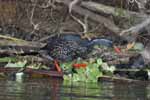

Our trip was drawing to a close, but we had one final National Park to visit, Lake Mburo. This park was devastated during the civil wars 35 years ago, when the infamous Idi Amin was toppled, as well as his successor. The current President, Yoweri Museveni, has been in office since 1986. The park has slowly recovered. Recently lions have returned, but their long absence has allowed zebras to do quite well there. Although the park is technically off limits to cattle, some well-connected ranchers in the area ignored this ban. The lake, though, produced two birds we wanted: The African Finfoot (Podica senegalensi) a strange bird in a small family containing only three species. We were lucky enough to see this female quite well, even managing to get a look at her curious foot. The other bird was the Papyrus Gonolek (Laniarius mufumbiri) a gorgeous bird we had been searching for in every patch of Papyrus we passed. Very shy, the bird didn't stay around long enough for a good photograph.
It was almost time to return home, but we had one final stop, in the second largest city in Uganda, Jinja, near the mouth of the Nile on Lake Victoria.
Jinja, Mabira Forest, and Back Home
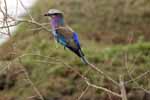
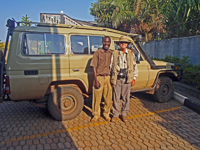
We left Lake Mbura after a late breakfast, meaning one eaten at 6:30, and set off for a long drive to Jinja. We stopped by a small pond near the entrance to the park to check out several water birds, including the colorful Greater Painted-snipe. On a wire nearby, we spotted the beautiful Lilac-breasted Roller, one of the birds on our most wanted list.
Along the way, Livingstone stopped at what was advertised as a refuge, but which we recognized immediately as sewage ponds. There, we finally got a look, through the telescope, but a look nonetheless, at the fabled Shoebill. Livingstone was very relieved, and we were happy to add the bird to the list.
The drive to Jinja was complicated by the necessity of skirting around Kampala, which added a good two hours of traffic jams to the trip. Finally, late in the day, we passed over what used to be the source of the Nile and is now the site of a large hydroelectric dam, before arriving at the Gately on Nile Guesthouse, a lovely establishment with some of the best food of the trip. Curiously, the absolute best food was when we stayed in the most rustic accomodations, a cabin used by researchers in Ruhija. We were treated to large numbers of fruit bats and Marabou Storks in the trees at the edge of the water.
The next day, we drove back to Entebbe, stopping for the morning in the Mabira Forest, a small (20000 hectares) remnant rainforest. The forest has been slated for destruction to make way for a large sugar plantation. (Does the world really need more sugar?) Surprisingly, this has led to a protest by Ugandan locals, who want to protect the country's heritage of wildlife. There we got superb looks at one of the most difficult birds to observe well, White-spotted Flufftail. This skulker seldom emerges from the forest undergrowth, and didn't for us, but we managed to get far enough into the forest to coax one into view by playing a recording of its call.
Finally, we were back in Entebbe, our trip at an end after eighteen days. Altogether, we saw 453 species of birds (455 for Linda) of which 381 (382) were lifers, and 37 species of mammals, all lifers.